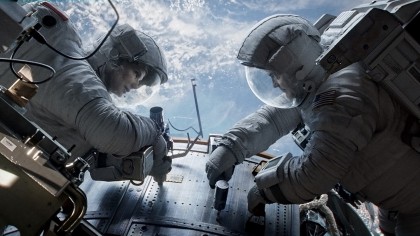The sound of silence: How Dolby Atmos brought gravitas to Gravity
You don't get this on a phone

"This film is basically silent, right? Because there's nothing in it."
That might seem like a strange thing for a sound designer to say. It might seem like a strange thing for the sound designer of runaway action hit, Gravity, to say. It definitely seems a strange thing for a sound designer to say about a film that is pretty much made for Dolby Atmos.
But sound doesn't travel in space so how do you handle space-sound in an action film that sells itself on its intergalactic realism?
Glenn Freemantle, Gravity's sound designer, describes the film as basically silent because every diegetic sound you hear was recorded specially for the film.
"The idea is that she Sandra Bullock's character hears things in space through touch, through her suit because there's oxygen and air in her suit - so we hear through her," Glenn Freemantle, Gravity's sound designer explains to us. "So we would record all the sounds like that - because it's the idea of sound through vibration, we recorded with contact mics which record that vibration.
"That whole idea came out in the first meeting we had in 2010. So the style [of the sound] was conceived then, right at the beginning. It wasn't something we kept changing. So rather than bang, crash, wallop, we wanted to try and make what she was in, how she was hearing it, how she was feeling it as real as possible."
In a regular film, the sound comes at you from either five speakers (5.1) or seven (7.1). The sound team on Gravity decided from the get-go to opt for 7.1, giving them three speakers at the front of the theatre, one on each side and one at the rear to play with.
Sign up for breaking news, reviews, opinion, top tech deals, and more.

But while Gravity was in production, Dolby debuted its new Atmos system.
Atmos adds a whole load more speakers into the mix - up to 64, in fact. The audience is surrounded by speakers so that sound can glide smoothly around the room rather than hopping from front to back in two or three jumps.
The sound of thunder to the west can come from a speaker overhead and to the west - or, in Gravity's case, space debris can come hurtling from 12 Azimuth degrees from due North so when it hits, the sound can travel through speakers from 12 degrees from due North. In simple terms, it's 3D for sound.
This works particularly well in Gravity, which "has Atmos written all over it", according to Freemantle.
"The whole idea is that the whole film moves. All the time. Every aspect of it," he explains - and if you've seen Gravity then you'll know what he means.
"It helps people feel it - you don't just hear it, you feel it."
There's barely a moment of stillness during the film's 91 minute runtime. Characters and equipment constantly tumble through zero-gravity, making any time they are strapped into place a huge relief. While that's disorientating enough in a regular 2D screening, a 3D screening ups the ante and Atmos puts it right on the verge of sickness-inducing.
"When we wanted to get from the back and then move, say, George [Clooney] around from there to over there, Atmos lets us move everything smoothly - and you can just follow him, follow him, follow him," Freemantle says. "You track him rather than just hitting that side and then that side.
"It's not only the dialogue that's doing that - everything that's attached to that character will be moving. It's exactly what we wanted to do and we designed it that way from the beginning, but the Atmos gave you that smooth movement so you can actually feel that movement and rotation - you're almost inside it.
Former UK News Editor for TechRadar, it was a perpetual challenge among the TechRadar staff to send Kate (Twitter, Google+) a link to something interesting on the internet that she hasn't already seen. As TechRadar's News Editor (UK), she was constantly on the hunt for top news and intriguing stories to feed your gadget lust. Kate now enjoys life as a renowned music critic – her words can be found in the i Paper, Guardian, GQ, Metro, Evening Standard and Time Out, and she's also the author of 'Amy Winehouse', a biography of the soul star.